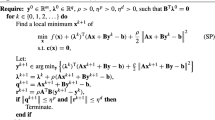Abstract
The proximal method of multipliers, originally introduced as a way of solving convex programming problems with inequality constraints, is a proximally stabilized alternative to the augmented Lagrangian method that is sometimes called the proximal augmented Lagrangian method. It has gained attention as a vehicle for deriving decomposition algorithms for wider formulations of problems in convex optimization than just convex programming. Here those themes are developed further. The basic algorithm is articulated in several seemingly different formats that are equivalent under exact computations, but diverge when minimization steps are executed only approximately. Stopping criteria are demonstrated to maintain convergence to a particular solution despite such approximations. Q-linear convergence is obtained from a metric regularity property of the Lagrangian mapping at the solution that acts as a mildly enhanced condition for local optimality on top of convexity and is generically available, in a sense. Moreover, all this is brought about with the proximal terms allowed to vary in their underlying metric from one iteration to the next. That generalization enables the results to be translated to the theory of the progressive decoupling algorithm, significantly adding to its versatility and providing linear convergence guarantees in its broad applicability to techniques for problem decomposition.
Similar content being viewed by others
Data availability:
No data was generated or analyzed.
Notes
The ambiguity in the Lagrangian formula when \(f(x)=\infty \) and \(g^*(y)=\infty \) is resolved by (1.1) as \(l(x,y)=\infty \).
The possibility of \(\alpha _k=0\) can be covered through a work-around that for every \(r'>r\) requires \(\alpha _{k+1}\le r'\alpha _k\) when k is sufficiently large.
For the sake of these extremes, the expression for r would better be taken in the form \(a_\infty /\sqrt{a_\infty ^2+c_\infty ^2}\), but the form in (2.25) is superior otherwise for emphasizing that the rate only depends on the ratio between \(c_\infty \) and \(a_\infty \) when they are finite.
Because the nonexpansivity is actually “firm nonexpansvity.”
If either the projection on S or the projection on \(S^\perp \) is readily computable, then so too is the other, according to the complementarity in (4.3).
Of course, it could be assumed for simplicity that these bounds hold for all z and w in H, but only this much is needed in our analysis.
References
Dontchev, A.D., Rockafellar, R.T.: Implicit Functions and Solution Mappings, 2nd edn. Springer (2014)
Hestenes, M.: Multiplier and gradient methods. J. Optim. Theory Appl. 4, 303–320 (1969)
Ismailov, A.F., Solodov, M.V.: Perturbed augmented Lagrangian method framework with applications to proximal and smoothed variants. J. Optim. Theory Appl. 193, 491–522 (2022)
Luque, F.J.: Asymptotic convergence analysis of the proximal point algorithm. SIAM J. Control Opt. 22, 277–293 (1984)
Parente, L.A., Lotito, P.A., Solodov, M.V.: A class of inexact variable metric proximal point algorithms. SIAM J. Optim. 19, 240–260 (2008)
Powell, M.J.D.: A method for nonlinear optimization in minimization problems. In: Fletcher, R. (ed.) Optimization, pp. 283–298. Academic Press (1969)
Rockafellar, R.T.: Convex Analysis. Princeton University Press (1970)
Rockafellar, R.T.: Conjugate Duality and Optimization. No. 16 in Conference Board of Mathematical Sciences Series, SIAM Publications (1974)
Rockafellar, R.T.: Monotone operators and the proximal point algorithm. SIAM J. Control Optim. 14, 877–898 (1976)
Rockafellar, R.T.: Augmented Lagrangians and applications of the proximal point algorithm in convex programming. Math. Oper. Res. 1, 97–116 (1976)
Rockafellar, R.T., Wets, R.J.-B.: Scenarios and policy aggregation in optimization under uncertainty. Math. Oper. Res. 16, 119–147 (1991)
Rockafellar, R.T.: Progressive decoupling of linkages in monotone variational inequalities and convex optimization. In: Hojo, M., Hoshino, M., Takahashi, W. (eds.) Proceedings of the 10th International Conference on Nonlinear Analysis and Convex Analysis (Chitose, Japan, 2017), Yokohama Publishers, pp. 271–291 (2019)
Rockafellar, R.T.: Progressive decoupling of linkages in optimization and variational inequalities with elicitable convexity or monotonicity. Set-Valued Var. Anal. 27, 863–893 (2019)
Rockafellar, R.T.: Augmented Lagrangians and hidden convexity in sufficient conditions for local optimality. Math. Program. 198, 159–194 (2023). https://doi.org/10.1007/s10107-022-01768-w
Rockafellar, R.T.: Advances in convergence and scope of the proximal point algorithm. J. Nonlinear Convex Anal. 22, 2347–2375 (2021)
Rockafellar, R.T.: Convergence of augmented Lagrangian methods in extensions beyond nonlinear programming. Math. Program. 199, 375–420 (2023). https://doi.org/10.1007/s10107-022-01832-5
Rockafellar R.T.: Metric regularity properties of monotone mappings. Mathematica Serdica (memorial issue for Asen Dontchev). Accepted
Rockafellar R.T.: Generic linear convergence through metric subregularity in a variable-metric extension of the proximal point algorithm. Comput. Optim. Appl. https://doi.org/10.1007/s10589-023-00494-z
Rockafellar, R.T., Wets, R.J.-B.: Variational Analysis. No. 317 in the series Grundlehren der Mathematischen Wissenschaften, Springer (1997)
Sefi, R., Teboulle, M.: Rate of convergence analysis of decomposition methods based on the proximal method of multipliers for convex minimization. SIAM J. Optim 24, 269–297 (2014)
Spingarn, J.: Partial inverse of a monotone operator. Appl. Math. Optim. 10, 247–265 (1983)
Spingarn, J.: Applications of the method of partial inverses to convex programming: decomposition. Math. Program. 32, 199–223 (1985)
Author information
Authors and Affiliations
Corresponding author
Ethics declarations
Conflict of interest:
None.
Additional information
Publisher's Note
Springer Nature remains neutral with regard to jurisdictional claims in published maps and institutional affiliations.
Rights and permissions
Springer Nature or its licensor (e.g. a society or other partner) holds exclusive rights to this article under a publishing agreement with the author(s) or other rightsholder(s); author self-archiving of the accepted manuscript version of this article is solely governed by the terms of such publishing agreement and applicable law.
About this article
Cite this article
Rockafellar, R.T. Generalizations of the proximal method of multipliers in convex optimization. Comput Optim Appl 87, 219–247 (2024). https://doi.org/10.1007/s10589-023-00519-7
Received:
Accepted:
Published:
Issue Date:
DOI: https://doi.org/10.1007/s10589-023-00519-7



